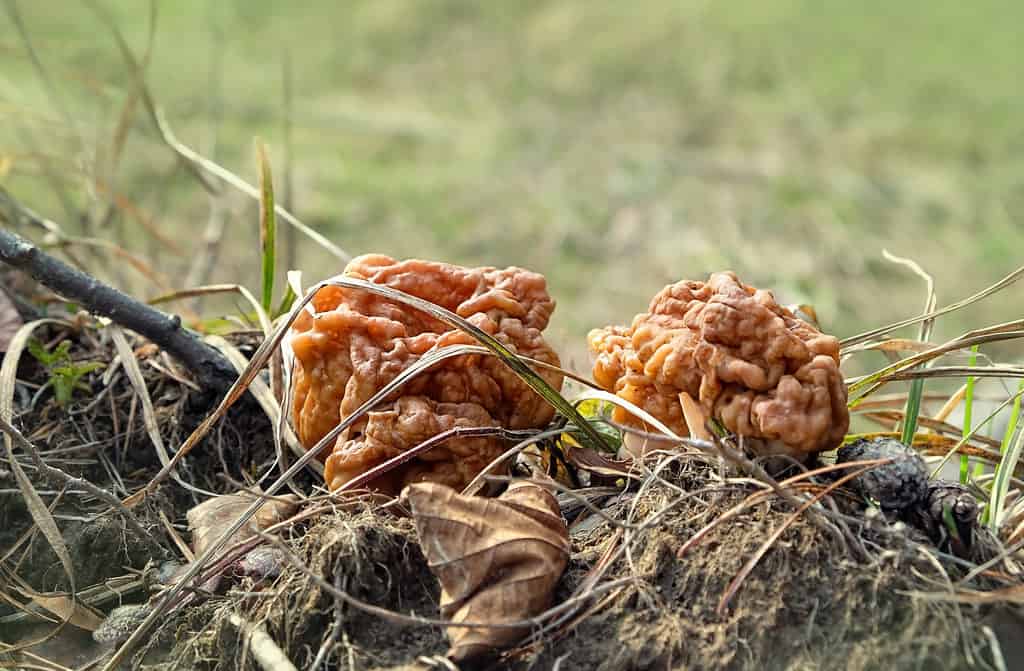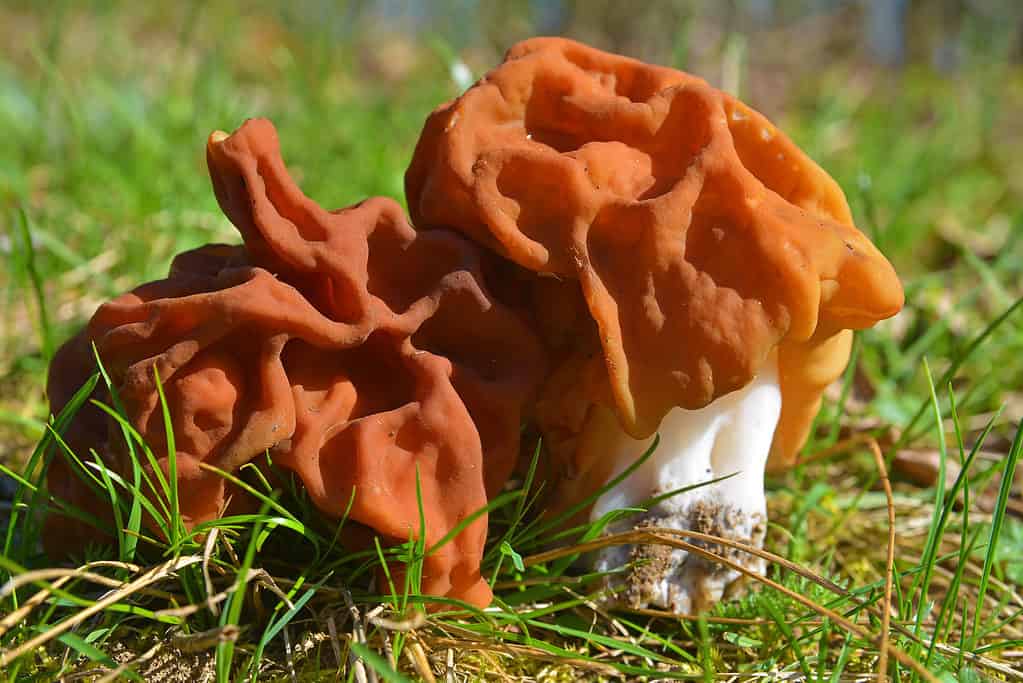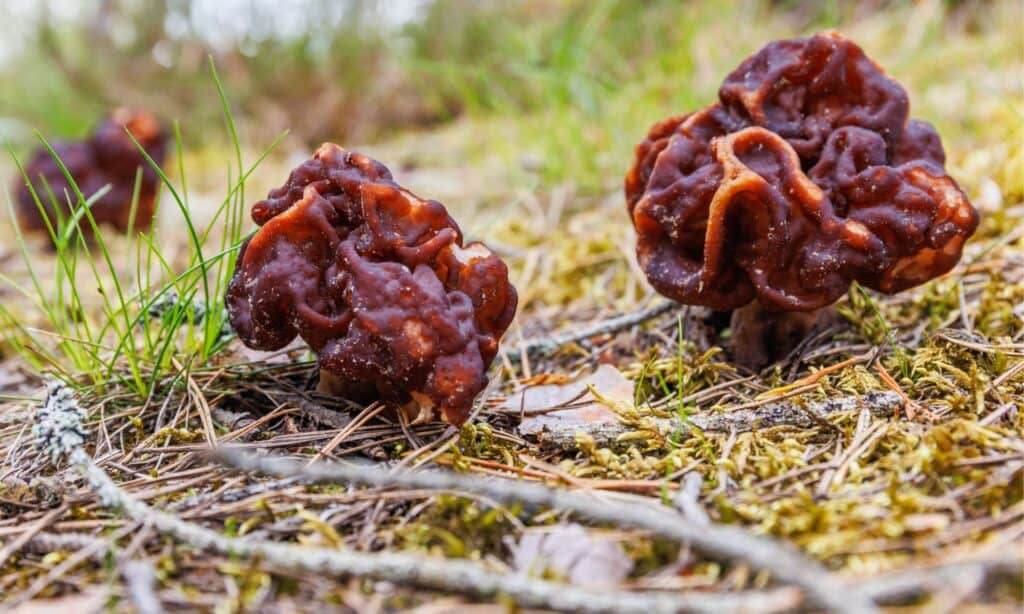If you’re interested in the wonderful world of foraging edible mushrooms, you may be familiar with the delicious and unique-looking morel mushrooms. However, look-alikes exist – aptly named false morels – that can trick the untrained eye into thinking you’ve found a true morel.
So, in this guide, we’ll cover the most common false morels, how to identify them, and how they compare to true morels.
Without further ado, let’s jump in!
False Morels: Classification
While true morels belong to the Morchella genus, and the Morchellaceae family of fungi, false morels mostly belong to the Gyromitra genus. This genus is classified into the Discinaceae family.
It’s important to note that mycology is a young field concerning modern scientific study, and you’ll find that it’s not uncommon for mycologists to disagree on fungal taxonomy or to reposition species or genera into a new or different fungal family.
The most common false morels include the following: Gyromitra esculenta, Gyromitra gigas, and Gyromitra caroliniana. These three species are the most widely agreed upon as false morels. Other mushrooms, such as some species in the Verpa genus, are considered false morels by some in the mycology community, but as this status is currently under a compelling debate, in this guide we will stick with the false morels in the Gyromitra genus.
Additionally, both true and false morels belong to the Ascomycota phylum of fungi that are known as “sac fungi”.

is one of three species widely agreed upon as false morels.
©ju_see/Shutterstock.com
How to Distinguish True vs. False Morels
While false morels can describe a group of mushrooms across different fungi families, these mushrooms tend to share some characteristics and have distinct identifiers.
Check Inside the Mushroom
Firstly, the mushrooms commonly known as “false morels” are not hollow. When you cut them open, you’ll notice they have fibrous, chamber-like structures inside. If you think you may have found a true morel, cut the mushroom vertically down the middle as true morels are hollow inside.

An easy way to confirm if you have found a true morel mushroom is to cut it open down the middle as true morels are hollow inside.
©iStock.com/Helin Loik-Tomson
Take a Look at the Cap
Secondly, while false morels have similar-appearing caps to true morels, their structures diverge from the cap characteristics of true morels. False morels can have brain-like, heavily wrinkled, wavy, or even smooth caps. However, they don’t contain the pitted, hollow, honeycomb-like structure of true morel caps.
Also, the caps of false morels usually aren’t as uniformly conical as true morels. Often, the caps of false morel are more squashed, and not uniform in appearance.
For example, let’s compare a true morel, Morchella esculenta, with a false morel, Gyromitra gigas. The cap of Morchella esculenta is uniformly conical. Its cap is brown and covered with honeycomb-like, spongy holes. Now, in comparison, the cap of Gyromitra gigas is orange to red and has a prominent, brain-like cap that is not uniform in shape and has a noticeably squashed appearance. While the cap may appear at first glance to have a hollow, honeycomb-like structure like a true morel, upon further inspection, you’ll notice that the cap is deeply wrinkled versus filled with actual holes.

False morels can have brain-like, heavily wrinkled, wavy, or even smooth caps that are more squashed, and not uniform in appearance.
©iStock.com/948451802
How Does the Stem Attach to the Cap?
Another important characteristic to check when distinguishing false morel vs. true morel is how the stem (“stipe” in mycology terms) attaches to the cap. With false morels, the cap is freely attached to the stipe. This means that the stipe is only attached to the center of the cap, while the rest of the cap freely hangs. In contrast, the majority of the caps of true morels are attached entirely to the stipe. The exception is the half-free morel, Morchella punctipes, which is attached to the stipe by the top half of the cap, with the bottom portion of the cap hanging free.

The majority
of the caps of true morels are attached entirely to the stipe.
©Mircea Costina/Shutterstock.com
Where and When Did You Find It?
When foraging for and identifying mushrooms, it’s always a good idea to note where and when you’ve found the mushroom. Making these notes can help you distinguish between false and true morels and could help you identify what species of false morel you’re looking at. You’ll want to note things such as:
- If you found it in a field, forest, roadside, etc.
- What kind of forest – deciduous, coniferous, tropical, temperate?
- What kind of region – lowlands, mountains, wetlands?
- If you found it growing in the soil, on a decomposing log, or a living tree?
- If found on a tree, what kind?
- If found in the soil, what type of soil?
- When did you find it?
False morels are widespread and growing ranges depend on the species in question. For example, Gyromitra caroliniana typically grows in the US South, and the Mississippi and Ohio watersheds. It usually is found growing in hardwood forests near stumps and rotting logs. You can often find the fruiting body of this mushroom from early April through June. So, after noting the macroscopic features (what you can see with the naked eye) of the mushroom, and where and when you found it, you can begin referencing reputable, expert mushroom identification sites or books. Since true morels also can grow in a similar region, type of forest, and at a similar time as Gyromitra caroliniana, you’ll need to adeptly note macroscopic features (and microscopic if you have access to a microscope) to distinguish these mushrooms.
However, a false morel like Gyromitra esculenta should be easier to distinguish from true morels based on its growing location. Typically, these false morels grow on sandy soils in conifer forests under pine trees.

A false morel like
Gyromitra esculentacan be distinguished from true morels because they grow on sandy soils in conifer forests under pine trees.
©iStock.com/TT
Edibility of False Morels
The question of false morel edibility can be a bit complicated, and the answer often depends on where you live and the mycology literature you have access to. What is agreed upon by mycologists is that false morels in the Gyromitra genus contain the chemical, gyromitrin, which is converted in the body into the toxin, monomethylhydrazine (MMH). This toxin can affect the liver, central nervous system, and kidneys. Effects can range from mild symptoms, to neuro-degenerative disease, coma, and even death. As such, many mushroom guides do not recommend eating false morels in the Gyromitra genus.
However, you may be surprised to learn that Gyromitra esculenta is considered a delicacy, foraged, and sold in restaurants and markets in several regions of the world, including Finland, Poland, Bulgaria, and the Great Lakes region of the US. However, in Sweden, Norway, and Spain, mushrooms in the Gyromitra genus are banned from sale to the public.
So, why is there such a discrepancy over this poisonous mushroom? According to some reports, cooking can degrade gyromitrin enough that is it safe to eat. In Finland, for example, people sell these mushrooms with a warning label that notes their toxicity and directs consumers on exactly how to prepare the mushrooms for safer consumption. However, research varies on how much cooking actually degrades this toxin. As such, the bottom line is that eating mushrooms with questionable or precarious edibility statuses requires deeply understanding the risks and exactly how to prepare the mushroom in question. When in doubt, it is always best to defer to not consuming the mushroom.
Ecological Niche
Generally, mycologists categorize false morels as saprophytes. This means that these mushrooms derive their nutrients from decomposing and dead organic matter. As decomposers, these mushrooms contribute to recycling nutrients within their ecosystem. In comparison to saprophytes, mycorrhizal mushrooms derive their nutrients from entering into a symbiotic relationship with plants. In this relationship, the fungi provide moisture and nutrients to plants obtained by their underground fungal strands (hyphae) in exchange for plant sugars.
While mycologists typically consider false morels as saprophytic, growing research suggests some false morel species, such as Gyromitra caroliniana, exhibit both saprophytic and mycorrhizal behaviors during different stages of their life cycles.
Up Next
- Are Mushrooms & Other Fungus Plants?
- The 10 Best Culinary Mushrooms
- Black Trumpet Mushrooms: A Complete Guide
The photo featured at the top of this post is © Ksenia Lada/Shutterstock.com
The information presented on or through the Website is made available solely for general informational purposes. We do not warrant the accuracy, completeness, or usefulness of this information. Any reliance you place on such information is strictly at your own risk. We disclaim all liability and responsibility arising from any reliance placed on such materials by you or any other visitor to the Website, or by anyone who may be informed of any of its contents. None of the statements or claims on the Website should be taken as medical advice, health advice, or as confirmation that a plant, fungus, or other item is safe for consumption or will provide any health benefits. Anyone considering the health benefits of particular plant, fungus, or other item should first consult with a doctor or other medical professional. The statements made within this Website have not been evaluated by the Food and Drug Administration. These statements are not intended to diagnose, treat, cure or prevent any disease.
Sources
- A-Z Animals, Available here: https://a-z-animals.com/reviews/the-best-books-about-mushrooms-for-beginners-and-enthusiasts/
- Missouri Department of Conservation, Available here: https://mdc.mo.gov/discover-nature/field-guide/morels
- Mushroom Expert, Available here: https://www.mushroomexpert.com/gyromitra_caroliniana.html
- Global Biodiversity Information Facility, Available here: https://www.gbif.org/species/144093802
- Missouri Department of Conservation, Available here: https://education.mdc.mo.gov/discover-nature/field-guide/false-morels
- University of Wisconsin, Available here: http://bioweb.uwlax.edu/bio203/s2013/hammett-_will/nutrition.htm#:~:text=False%20morels%20are%20classified%20as,the%20right%20from%20blogspot.com
Thank you for reading! Have some feedback for us? Contact the AZ Animals editorial team.






